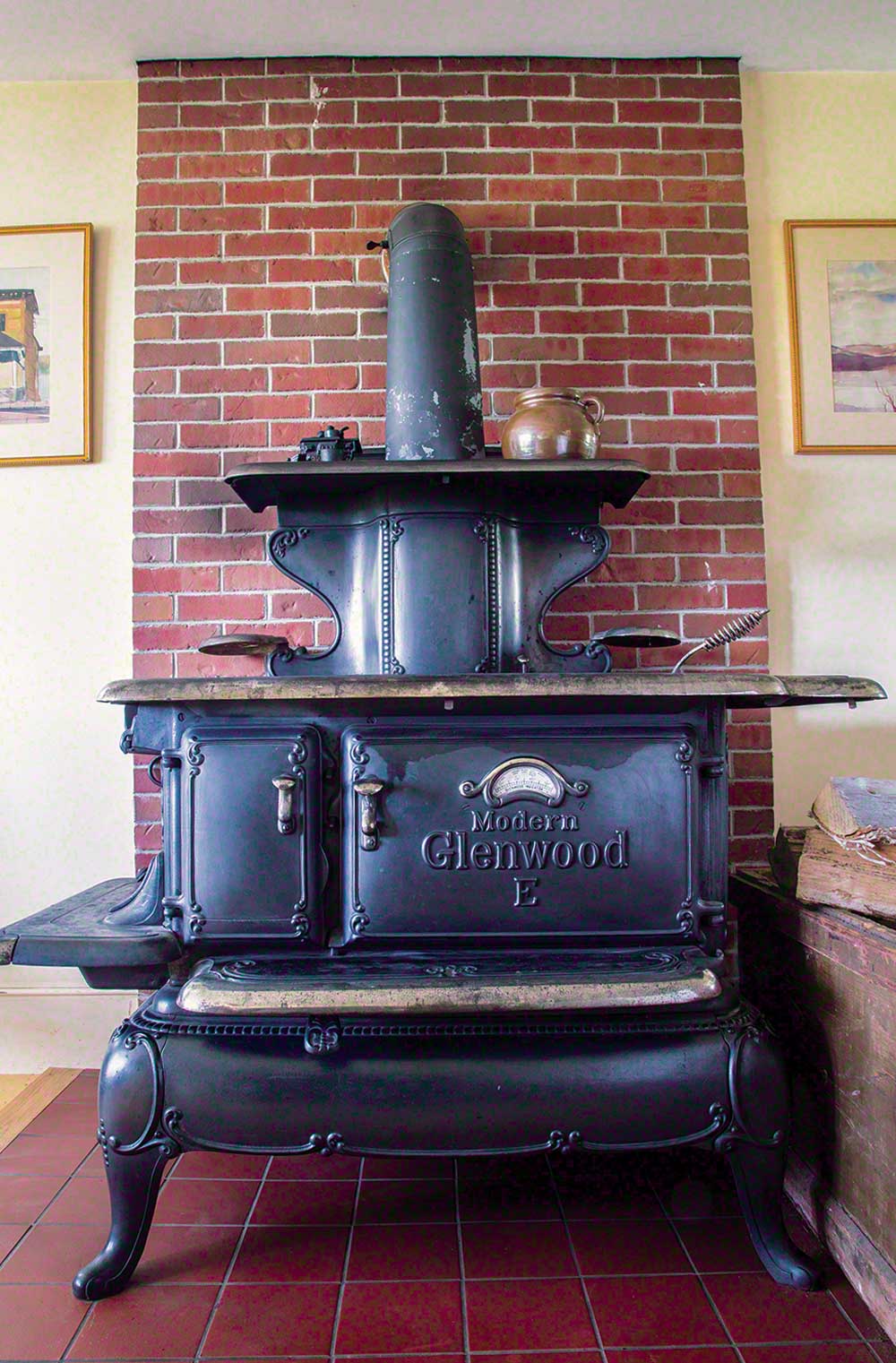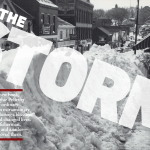The Mighty Glenwood Cookstove | New England’s Gifts
The Glenwood cookstove was America’s first true home appliance. Learn how gradually (very gradually) Yankee contributor Edie Clark learned that she could do many things on this stove that she couldn’t do on a modern stove.

Coffee By Design | Portland, Maine
Photo Credit : Katherine KeenanWhat was to become my stove was jammed into a freight car on the sidelines of the old train station in Littleton, Massachusetts. The stoves were pushed together willy-nilly, wherever space could be found. From this amazing jumble, Dave Erickson urged me to select one that most appealed; he would extract it and restore it to its former splendor. Outside, among the grasses, dozens more, mostly in pieces, awaited rescue. In the darkness of that freight car, I found what I was looking for: a diamond in the rough, no rust, the stylish legs and warming shelf still smooth and even a little shiny. And, like almost all the stoves in this vast yard, it had a story: It had belonged to an old lady in Fitchburg who hadn’t used it to burn wood, but instead had run gas pipes through it. As a result, the stove was in remarkably good condition. Dave reminisced a bit about the day he took it out of her kitchen. Then as now, no one can rhapsodize about a cookstove like Dave, who has kept his love affair with these beauties for some 35 years. He’s been an evangelist for old cookstoves almost as long as I.
The stove I chose was to replace one that my first husband and I had bought 10 years earlier from a hardware store in Brattleboro, Vermont—an antique sold “as is.” A Glenwood C manufactured in 1890, it was like new. That stove became the heart of our house and, most painfully, had to be sold with the house when we divorced some years later. A multitasker, the Glenwood burned wood, so it heated the house and its oven baked our bread and the stovetop cooked or heated just about anything. The oven door proclaimed Glenwood C in ornate, embossed lettering, and in the center of the name was the thermometer gauge for the oven. Beneath the oven door was a little pedal (beautifully decorated as well); if I pressed it with my foot, the door swung open so that I could easily put the turkey or whatever into the oven, not needing three hands. The various warming shelves not only kept dishes hot but at different temperatures: some warmed just a little, others almost cooked. Gradually, very gradually, I learned that I could do many things on this stove that I couldn’t do on a modern stove. I could even grill steaks. That stove turned me into a believer, a believer in the Glenwood, a believer in wood heat and wood cooking, and a believer in form and function, which these stoves displayed in spades. Now I needed a replacement, and I turned to stove restorer Dave Erickson in my search.
Almost everything I know about Glenwood stoves came to me first through trial-and-error but then through Dave. From him, I learned about dampers and draft slides, finials and footrests, towel racks and trivets, nickel plating, scrollwork, and sidecars. I’ve listened to him sermonize about the brilliance of butter warmers, clock shrines, and simmer burners and explain the physics of draft and the intricate and ingenious path the heat takes around the oven on its way up the chimney.
The one thing he’s never told me is that the Glenwood was America’s first home appliance. Stoves like mine came out of the massive fiery furnaces of the foundries of Taunton, Massachusetts, then known as “Stove City.” The Glenwood quickly replaced the hearth as a way to cook, distinguished by its ability to heat and bake with far more precision than an open fire.
Literally thousands of other foundries turned out cookstoves of all varieties in that booming era between the 1850s and World War I (when iron became more valuable for waging war than for cooking dinner). The Glenwood was simply the first and, in the opinion of many, including Dave, the best. “They’re the most durable, most reliable, and most beautiful, and they have an indestructible design,” he says. “They’re the Cadillac, the El-dorado, of stoves.”
The stove that Dave pulled out of that freight car back in the 1980s has followed me through the many phases of my life and now sits in my kitchen here at Mary’s Farm, facing another stove, also a Glenwood. That one cooks with gas and is clad in green-and-cream enamel, the name Glenwood also proudly shown on the oven door. The two stoves, one from the 19th century and the other from the 20th, rest on their graceful legs and catlike feet. Facing each other as they do, it sometimes seems as though they’re speaking to each other, and if they are, it’s a conversation I would love to hear.








I have a glenwood E 6burner stove looks to have all the parts. Not restored. Could you help me with what this may have as far ad value?? Thank you
I have the same stove. Do you know how it wors? I am not able to cook anything in oven The temperature does’t rise over 275.
I was having the same issue with mine until I did some troubleshooting. First, there is a small lever on the stove top by the chimney and when it is pointing a towards the back of the stove, the heat runs directly from the firebox to the chimney, only heating the stove top elements. When it is switched to the right, it forces the hot air to travel around the oven to get to the chimney, thus heating up the oven. However, if your stove is not clean, it will smoke as there is not a clear path for the heat and smoke to travel. If this is the case, open the trap door by the bottom right side of the stove and clean it right out, vacuum and all. I wasn’t able to get my stove much higher than 200 degrees. Now I don’t have any problems hitting 450.
I have a Glenwood C nickel and enamel cookstove that my mother used. We never had a house that could handle it and now that I am getting older I think I should sell it. Do you know how I should go about that? Thank you.
I have a Glenwood that I was told (by the original owner) was a one-of-kind Glenwood that was built specifically for display at the Brockton Fair. I would like to have some idea of its value. It’s very beautiful, the most beautiful one I’ve ever seen. Who could I ask about its value and the best way to preserve it.
i have a 1902 glenwoodf heats a 5 bedroom house all by it self in maine
I have a Glenwood C, with warming,oven was a barn find, everything original, poppers, mitten warmer, Execllent conditions, even the nickel execllent
Thanks for the article by the wonderful Edie Clark.
Pray she’s doing better after the stroke.
I had a Glenwood stove in the early 70’s, when I was a young mother and homemaker, I loved it and have many happy memories of trial & erorr, from baking bread to cooking free range chickens, which you had to keep turning to get the skin browned.
Thanks for a great article. I have never owned or used a Glenwood stove, but my mother and grandmother both did …. they are very much a part of our family history. We lived in Taunton, MA until the 60s, and my grandfather worked for Glenwood for many years prior to his death in 1945, before I was born. Like many people in Taunton, I grew up feeling very close to Glenwood because just about everyone you knew had a relative or friend who worked there.
I have a Glenwood Model C green and white enamel it is a stunning stove in very nice condition reason for selling I came to the conclusion my kitchen is just to small I love the stove around the holidays they are great tex if interested.
I bought a Glenwood C in Maine in 1971. It has been my most treasured possession ever since, and I have used it enormously both for cooking and heat in our Vermont home. I just baked a small sourdough loaf in it this afternoon. But I have one puzzlement. Perhaps a reader will have a thought. What is the special function of the vent on the upper left of the firebox? What advantage does that bring? I’ve experimented back and forth and don’t see much difference, open or shut.
Larry, that lever, when open, routes the smoke, heat, etc directly from the firebox to the chimney pipe. When closed, it routes the smoke, heat, etc across the top of the stovetop and oven and then up the flue from beneath the oven box. Open it when first lighting the stove and once you have a good fire going, close it to allow the entire stove to heat up. Be sure to periodically remove the front lower trim piece below the oven door in order to access the ash removal door for cleaning ash from below the oven.
Also, the vent that is above the firebox on the left side that slides is to adjust the stovetop temp…
You can flip the door down and insert a grill to cook steak, chops, hamburgers etc… over the fire. We use a camp fire clam shell grill with a long handle. They did make a cast iron grill specifically for the purpose but they are hard to find and expensive.
We are in the middle of purchasing a Glenwood C with a gas side car, completely rebuilt from Emorie at The Antique Stove Hospital in RI. Our home is off grid. We are seriously excited to get it!! It is fantastic to read all of the stories here of trial and error! Looking very forward to it. Have never used a wood cook stove before. Does anyone have any ideas about how to books? Thank you!
I have a f
Glenwood F, 1917. I love it but know very little about it. Can it burn coal and how do the vents, etc. work to cook more efficiently with it. Currently I only burn wood and use for auxiliary heat.
Great article! My son is named Glenwood after my grandfather. The family story is that the original Glenwood Hersey of Beverly Mass was named after the family stove.
My girlfriend has a grey enamel cook stove that looks identical to the glenwood but has a circular temp gauge on the door and “Happy Thought” cast into it instead of Glenwood. We have been unable to find any information on this stove, any information would be very appreciated.